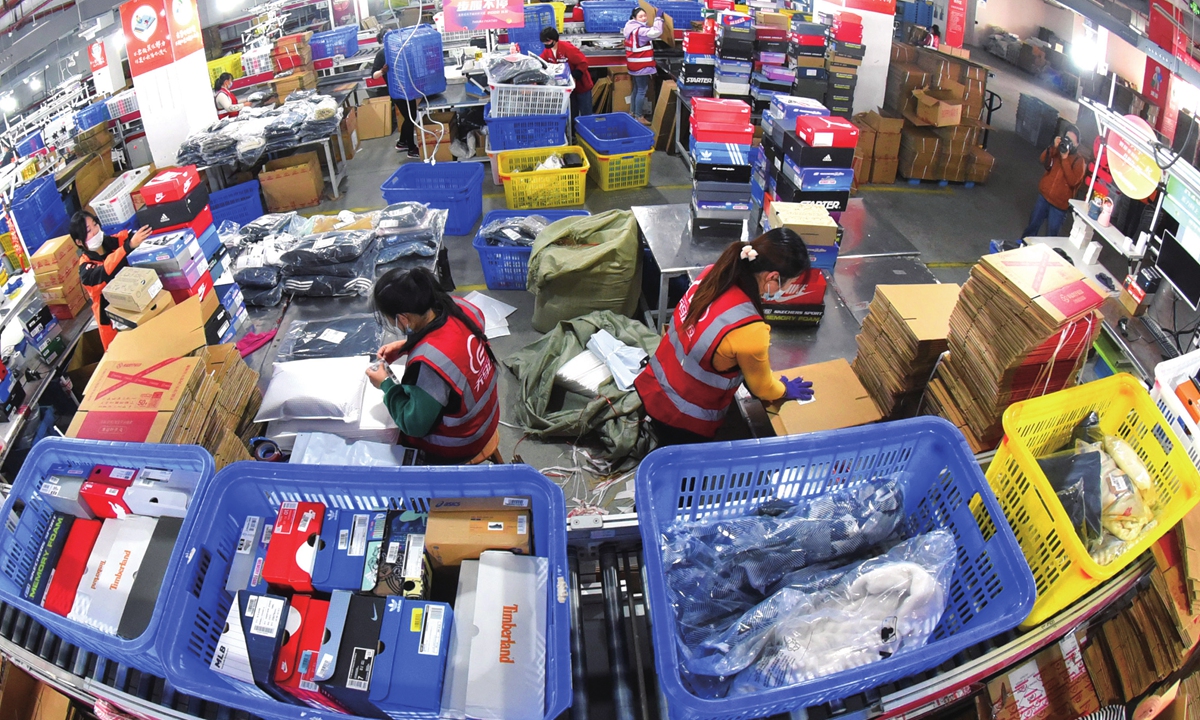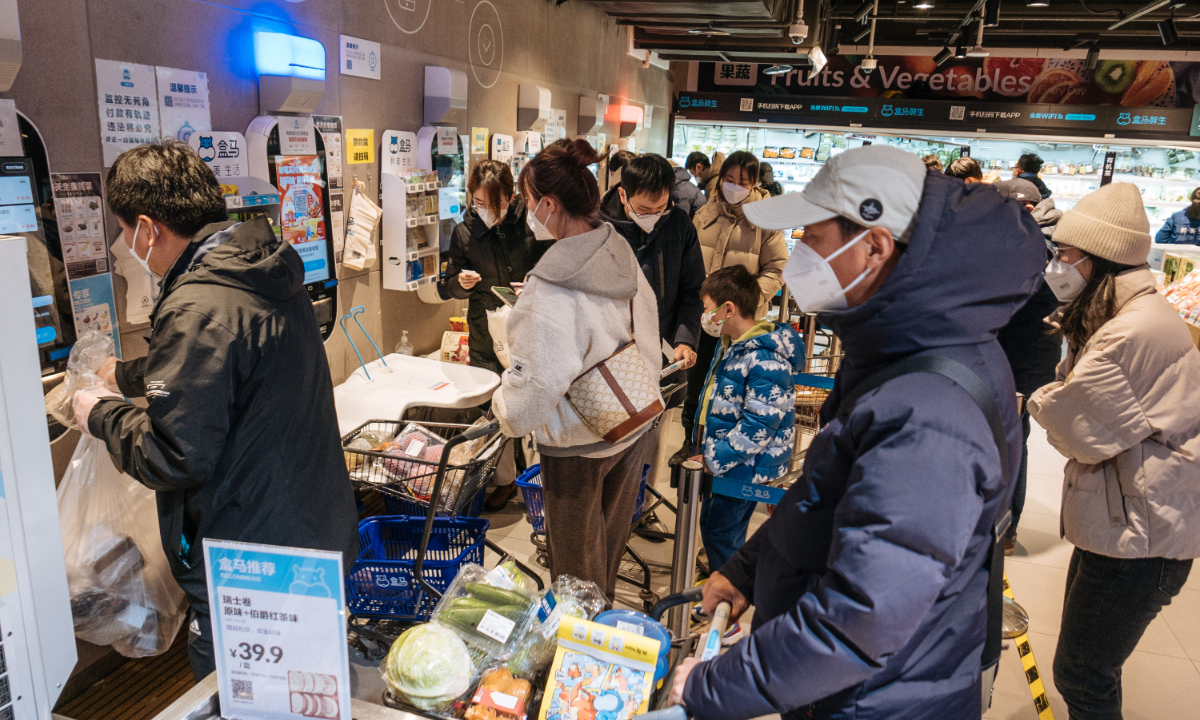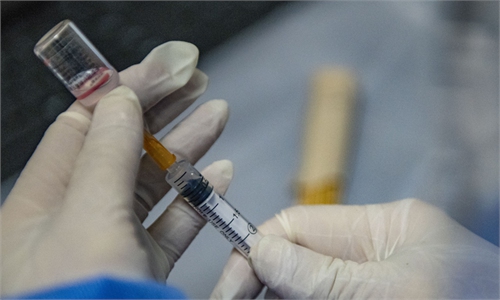Chinese cities race against clock to accelerate economic recovery
Resumption of pillar industries boosts analysts’ optimism for performance in 2023

Workers sort packages in an e-commerce industrial zone in Lianyungang, East China’s Jiangsu Province on November 11, 2022. Photo: Xinhua
From populous metropolises to small inland cities, different localities across China are striving to accelerate the pace of resuming work and production against the backdrop of major changes in COVID-19 response under the principle of the “10 new measures.”
Local authorities have rolled out policies to reduce enterprises’ burden, revitalize pillar industries, and stabilize supply chains as well as jobs, while businesses ranging from logistics and manufacturing to foreign trade and services are racing against the clock to speed up economic recovery, prompting analysts’ optimism over the country’s growth momentum.
Beijing authority on Sunday briefed the media its current progress made in resuming work and production, saying energy use in the secondary and tertiary sectors have risen 15.2 and 19 percent, respectively, in comparison to mid-November when the capital city was under strict restrictions to curb the spread of the Omicron virus.
Factories, construction sites and office buildings have reopened; 42 Beijing-administered state-owned enterprises have resumed work and firms manufacturing epidemic prevention supplies are racing against the clock to expand production, according to Sunday’s press conference.
At Monday’s press conference, Beijing authority said cap for employees’ attendance and routine nucleic acid testing of certain professions including non-cold chain imports and property agents have been removed.
Requirements for nucleic acid tests have been revoked for most places except those stipulated by the 10 new measures, including care centers, elementary and middle schools, and inpatient departments of hospitals.
Southwest China’s Chongqing Municipality, in a notice issued on Sunday, stipulated all venues except care centers, kindergartens, elementary and middle schools, stop checking nucleic acid tests. It also advised people without symptoms not to test or use medicines.
According to the Chongqing notice, employees of government departments, enterprises and institutions, with no or light symptoms, can return to work after taking prevention measures if necessary.
North China’s Shanxi Province has achieved a combined work resumption rate of 93.3 percent. Among them, power industry topped at 99.4 percent, followed by coal industry’s 95.4 percent and manufacturing’s 93.6 percent, Shanxi Daily reported on Monday.
Lüliang in Shanxi has allowed mining and chemical companies that halted production due to the epidemic to decide by themselves when to restart. The city also announced to postpone water and energy bills from December 2022 to March 2023 and grant subsidies to companies that increase employment in this period, according to a notice on the local government website.

Pillars for optimism
The traffic liveliness is seen as a key indicator of economic dynamics.
Besides the return of lines and crowds at subway stations in major cities like Beijing, domestic long-distance travel has also seen an increase in demand, with tickets for trips between cities tripling on major online ticket booking platforms.
A notice issued on Sunday by the Ministry of Transport requested speeding up the full resumption of passenger transport, striping checks of nucleic acid tests, health codes and tests upon arrivals.
The notice also asked operators to ventilate stations and vehicles properly, and asked industry personnel to get vaccinated and guide passengers to wear masks. Backup teams shall be established to prevent suspension of services due to infections, read the ministry’s notice.
Smooth transportation is also the foundation for another industry key to people’s livelihoods – logistics.
The Global Times learned from Yunda Express, a leading logistics company, on Monday that the company’s Beijing branch has 93 percent of its employees back in work. It has deployed couriers outside Beijing and re-allocated personnel among districts in Beijing to ease the shortage of labor in some areas.
An outlet in Daxing district used 32 unmanned delivery vehicles that are able to send more than 6,000 parcels a day.
The company strictly conducts disinfection of parcels and requires employees to wear N95 face masks to prevent infections. “We adjusted and removed some key performance (KPI) at our Beijing outlets, and gave out anti-COVID subsidies. We also offered extra subsidies for employees at distribution centers,” read a statement Yunda sent to the Global Times.
Foreign trade-oriented companies are also grasping the opportunity to pick up production.
Lu Huazhen, representative from a knitting enterprise in Zhuji, East China’s Zhejiang Province, told the Global Times on Monday that the company’s production lines are fully running to meet increasing overseas orders.
She said that some workers have shown COVID-19 symptoms, but there is no panic within the factory as the company provides fever and cold drugs as well as paid leaves to ensure the health of workers.
Lu expressed optimism for the trade prospect in 2023, saying her company has received orders for warm leggings of about 3 million pairs from Europe. She said that the company will make sound arrangement for the Spring Festival holidays to ensure output, and plans to grant rewards to encourage workers to return to their positions earlier.
Dong Shaopeng, a senior research fellow at the Chongyang Institute for Financial Studies at Renmin University of China, told the Global Times on Monday that China is now at the initial stage of the comprehensive recovery of economic and social activities at all fronts.
Offline services sectors such as catering, accommodation and tourism have just embarked on the route of recovery after the latest optimization of COVID-19 response, Dong said.
Beijing, which is one of the earliest cities to confront massive infections, is on track to fully restore social life back to normal, with catering, retail and entertainment all witnessing a sign of rebound after a weeklong infection peak.
For places where infections were less severe or the peak has yet to come, people have already enjoyed daily lives at ease since the launch of the 10 new measures.
With infection risks looming, catering, retail and tourism still need time to fully recover, while different cities have varying paces of doing so in accordance with scales of population and realities of infections, observers said.
However, the worst period when China’s economy was hit hard by the COVID-19 has passed and the second quarter of 2023 may be a turning point for the complete recovery of domestic economy,” Dong said while holding the belief that the Chinese economy may grow by around 5 percent in 2023.
Some bolder predictions set the potential growth rate to be at about 6 to 8 percent in 2023, thanks to confidence in the better response to the COVID and a series of pro-growth policy measures outlined by top policymakers during the annual Central Economic Work Conference that concluded on Friday, according to economic analysts at the Global Times Annual Forum on Saturday.
Local authorities have rolled out policies to reduce enterprises’ burden, revitalize pillar industries, and stabilize supply chains as well as jobs, while businesses ranging from logistics and manufacturing to foreign trade and services are racing against the clock to speed up economic recovery, prompting analysts’ optimism over the country’s growth momentum.
Beijing authority on Sunday briefed the media its current progress made in resuming work and production, saying energy use in the secondary and tertiary sectors have risen 15.2 and 19 percent, respectively, in comparison to mid-November when the capital city was under strict restrictions to curb the spread of the Omicron virus.
Factories, construction sites and office buildings have reopened; 42 Beijing-administered state-owned enterprises have resumed work and firms manufacturing epidemic prevention supplies are racing against the clock to expand production, according to Sunday’s press conference.
At Monday’s press conference, Beijing authority said cap for employees’ attendance and routine nucleic acid testing of certain professions including non-cold chain imports and property agents have been removed.
Requirements for nucleic acid tests have been revoked for most places except those stipulated by the 10 new measures, including care centers, elementary and middle schools, and inpatient departments of hospitals.
Southwest China’s Chongqing Municipality, in a notice issued on Sunday, stipulated all venues except care centers, kindergartens, elementary and middle schools, stop checking nucleic acid tests. It also advised people without symptoms not to test or use medicines.
According to the Chongqing notice, employees of government departments, enterprises and institutions, with no or light symptoms, can return to work after taking prevention measures if necessary.
North China’s Shanxi Province has achieved a combined work resumption rate of 93.3 percent. Among them, power industry topped at 99.4 percent, followed by coal industry’s 95.4 percent and manufacturing’s 93.6 percent, Shanxi Daily reported on Monday.
Lüliang in Shanxi has allowed mining and chemical companies that halted production due to the epidemic to decide by themselves when to restart. The city also announced to postpone water and energy bills from December 2022 to March 2023 and grant subsidies to companies that increase employment in this period, according to a notice on the local government website.

Shoppers line up to use self checkout services at a Hema Fresh store in Beijing on December 17, 2022. Photo: Li Hao/GT
Pillars for optimism
The traffic liveliness is seen as a key indicator of economic dynamics.
Besides the return of lines and crowds at subway stations in major cities like Beijing, domestic long-distance travel has also seen an increase in demand, with tickets for trips between cities tripling on major online ticket booking platforms.
A notice issued on Sunday by the Ministry of Transport requested speeding up the full resumption of passenger transport, striping checks of nucleic acid tests, health codes and tests upon arrivals.
The notice also asked operators to ventilate stations and vehicles properly, and asked industry personnel to get vaccinated and guide passengers to wear masks. Backup teams shall be established to prevent suspension of services due to infections, read the ministry’s notice.
Smooth transportation is also the foundation for another industry key to people’s livelihoods – logistics.
The Global Times learned from Yunda Express, a leading logistics company, on Monday that the company’s Beijing branch has 93 percent of its employees back in work. It has deployed couriers outside Beijing and re-allocated personnel among districts in Beijing to ease the shortage of labor in some areas.
An outlet in Daxing district used 32 unmanned delivery vehicles that are able to send more than 6,000 parcels a day.
The company strictly conducts disinfection of parcels and requires employees to wear N95 face masks to prevent infections. “We adjusted and removed some key performance (KPI) at our Beijing outlets, and gave out anti-COVID subsidies. We also offered extra subsidies for employees at distribution centers,” read a statement Yunda sent to the Global Times.
Foreign trade-oriented companies are also grasping the opportunity to pick up production.
Lu Huazhen, representative from a knitting enterprise in Zhuji, East China’s Zhejiang Province, told the Global Times on Monday that the company’s production lines are fully running to meet increasing overseas orders.
She said that some workers have shown COVID-19 symptoms, but there is no panic within the factory as the company provides fever and cold drugs as well as paid leaves to ensure the health of workers.
Lu expressed optimism for the trade prospect in 2023, saying her company has received orders for warm leggings of about 3 million pairs from Europe. She said that the company will make sound arrangement for the Spring Festival holidays to ensure output, and plans to grant rewards to encourage workers to return to their positions earlier.
Dong Shaopeng, a senior research fellow at the Chongyang Institute for Financial Studies at Renmin University of China, told the Global Times on Monday that China is now at the initial stage of the comprehensive recovery of economic and social activities at all fronts.
Offline services sectors such as catering, accommodation and tourism have just embarked on the route of recovery after the latest optimization of COVID-19 response, Dong said.
Beijing, which is one of the earliest cities to confront massive infections, is on track to fully restore social life back to normal, with catering, retail and entertainment all witnessing a sign of rebound after a weeklong infection peak.
For places where infections were less severe or the peak has yet to come, people have already enjoyed daily lives at ease since the launch of the 10 new measures.
With infection risks looming, catering, retail and tourism still need time to fully recover, while different cities have varying paces of doing so in accordance with scales of population and realities of infections, observers said.
However, the worst period when China’s economy was hit hard by the COVID-19 has passed and the second quarter of 2023 may be a turning point for the complete recovery of domestic economy,” Dong said while holding the belief that the Chinese economy may grow by around 5 percent in 2023.
Some bolder predictions set the potential growth rate to be at about 6 to 8 percent in 2023, thanks to confidence in the better response to the COVID and a series of pro-growth policy measures outlined by top policymakers during the annual Central Economic Work Conference that concluded on Friday, according to economic analysts at the Global Times Annual Forum on Saturday.

